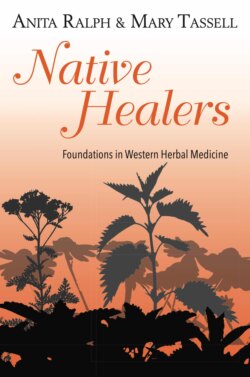Читать книгу Native Healers - Anita Ralph - Страница 4
На сайте Литреса книга снята с продажи.
ОглавлениеCONTENTS
PREFACE
ACKNOWLEDGEMENTS
INTRODUCTION
CHAPTER ONE
Drawing from the deep pool: the history, scope and core principles of herbal medicine in the West
History and origins
Key concepts of Western herbal medicine
Core foundational principles of herbal practice
The framework of the book
Key concepts about medicinal plants
Key concepts of the approach of the Western medical herbalist
Evidence
Herbal safety
Case history
Placebo and nocebo
A mini case history
Quick checklist for clinicians advising patients about the use of herbal medicine
The future
CHAPTER TWO
Developing knowledge of plants: an introduction to plant science
Introduction
The scientific naming of plants
Four important medicinal plant families
Carrot family (Apiaceae)
Mint family (Lamiaceae)
Daisy family (Asteraceae)
Rose family (Rosaceae)
Plant constituents
Mucilages
Tannins
Saponins
Essential oils
Sensorial tasting of medicinal plants
CHAPTER THREE
The human body: a herbalist's eye view
Introduction
Key concepts
The immune system
The endocrine system
The nervous system
The five senses
The digestive system
The cardiovascular system
The reproductive system
The lymphatic system
The renal system (kidneys)
The musculoskeletal system
The respiratory tract
Conclusions
CHAPTER FOUR
Native healers: five key plants from the Western herbal tradition
Introduction
Five essential healing medicinal plants
Chamomile (Matricaria chamomilla (L.) Rauschert)
Fennel (Foeniculum vulgare Mill.)
Elder (Sambucus nigra L.)
Lemon balm (Melissa officinalis L.)
Meadowsweet (Filipendula ulmaria L.)
CHAPTER FIVE
Food, nutrition and wellness
Introduction
Water
Nutrient food groups—biomolecules and macronutrients
Carbohydrates, lipids, proteins and nucleic acids
Vitamins
Minerals
Inflammation and diet
Foods with ‘bad press’
Salt
Sugar
Bread—(The staff of life?)
Gut biota and the microbiome
Taste
The four temperaments of Greek and Unani medicine
Seasonal eating and foraging
Antioxidants, free radicals and phytonutrients
Conclusion
How to eat well
CHAPTER SIX
Native healers: five more key plants from the Western herbal tradition
Introduction
Five magnificent plant tonics
Hawthorn (Crataegus species)
Marigold (Calendula officinalis L.)
Lime blossom (Tilia x europea L. and Tilia cordata Mill.)
Lavender (Lavandula angustifolia L.)
Nettle (Urtica dioica L.)
CHAPTER SEVEN
Swimming upstream: common conditions and therapeutic considerations
Introduction
Part 1. Menopause and peri-menopause
Part 2. Migraine
CHAPTER EIGHT
Native healers: five more key plants from the Western herbal tradition
Introduction
Five magnificent plant protectors
Thyme (Thymus vulgaris L.)
Yarrow (Achillea millefolium L.)
Dandelion (Taraxacum officinale aggr. F. H. Wigg)
Marshmallow (Althea officinalis L.)
Cleavers (Galium aparine L.)
CHAPTER NINE
Swimming upstream: common conditions and therapeutic considerations
Introduction
Part 1. Respiratory tract infections
Part 2. Gastro-oesophageal reflux disease
CHAPTER TEN
Swimming upstream: common conditions and therapeutic considerations
Introduction
Part 1. Osteo-arthritis
Part 2. Sleep and insomnia
CHAPTER ELEVEN
Swimming upstream: common conditions and therapeutic considerations
Introduction
Part 1. Skin health (the skinny on skin)
Part 2. Irritable bowel syndrome
CHAPTER TWELVE
Conclusions: the counter-current revisited
Introduction
Evolution and energetics
Person-centred medicine
Plants and people
Plant complexity and synergy
The herbal approach
The magic of how we learned about plants
Kitchen pharmacy
The future of herbal medicine practitioners
GENERAL INDEX
RECIPE INDEX
CASE HISTORY INDEX
